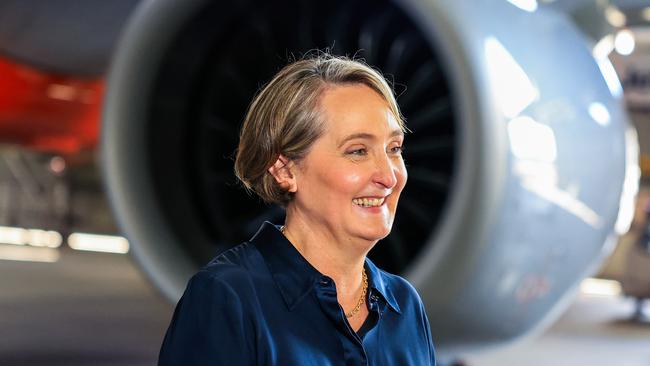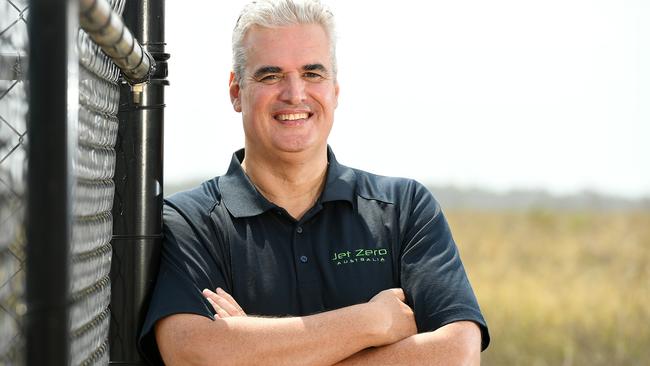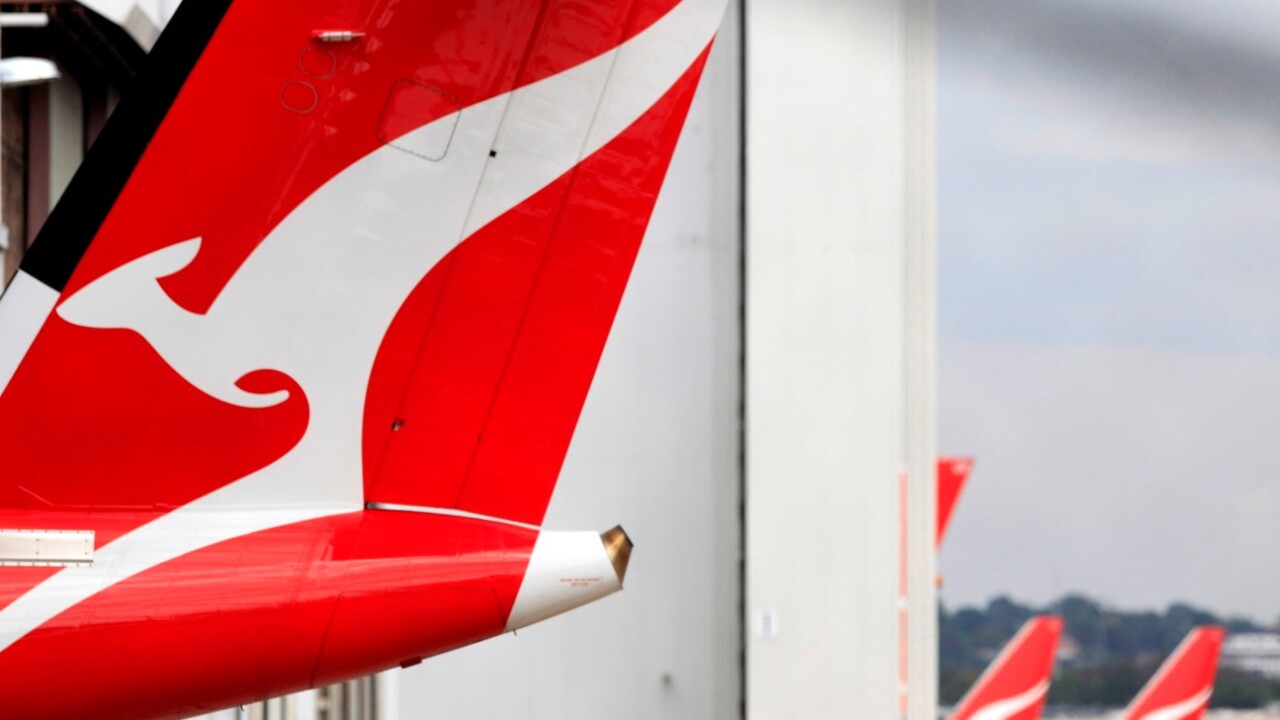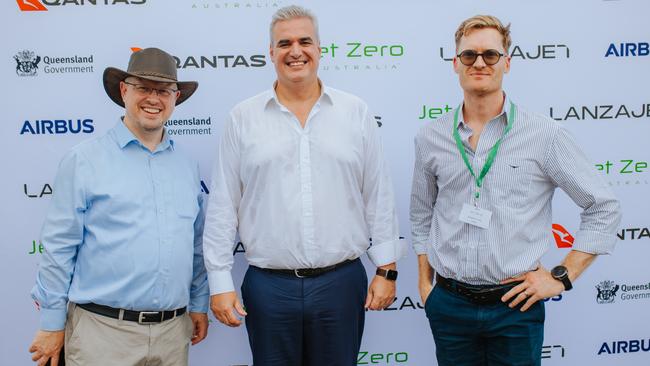Qantas chief Vanessa Hudson’s greatest challenge is decarbonising air travel
As well as costing trillions, decarbonising aviation fuel will require ‘bravery’, says Qantas CEO Vanessa Hudson. So is it possible or just fantasy that flights will one day be powered by farm waste and cooking oil?

Vanessa Hudson, chief executive of Qantas, faces plenty of challenges, but the really big one is turning the aviation sector green. To her, decarbonising air flight is more challenging than the impact of the 9/11 terror attacks, the global financial crisis, and the crippling Covid-19 pandemic.
That might seem a big call; after all, the pandemic cost the national carrier about $20bn in revenue plus 8500 jobs, and brought it to the brink of bankruptcy.
But taking the carbon out of flying is likely to cost trillions and will need big tech breakthroughs, traveller support and cooperation from governments and regulators. It’s also likely to need a heap of agricultural waste, from sugar cane residue, tallow, used vegetable oil, feedstock and woodchips, as the sector searches for cleaner fuel.

This is an article from The List: 100 Top Energy Players 2024, which is announced in full on November 22.
Existing sources of renewable energy are of little use to airlines, which are reliant on fossil fuel powered aircraft. Electric aircraft are being developed but their limitations are obvious, with restrictions on range and passenger numbers.
Hydrogen-powered planes are also in the pipeline but they too pose challenges, including storage and refuelling, plus aircraft would need to carry three times as much hydrogen to do the job of one tank of jet fuel.
New generation aircraft have delivered reduced emissions and fuel burn to airlines but not enough to achieve ambitious sustainability targets alone. That leaves one option – sustainable aviation fuel (SAF), made from agricultural waste. And if it seems odd that the oil used to cook a takeaway meal will end up powering your flight over the Pacific, that’s the best airlines have to work with at the moment.
“We are going to have to be brave,” Hudson told the recent Infrastructure Partnerships Australia conference.
“We are going to have to invest and put our money where our mouth is. What we don’t want to have happen, like we’ve seen in other jurisdictions, is where there is flight shaming or where governments make regulation decisions that curb travel.”
Why Australian aviation is lagging behind
Australia has produced no sustainable aviation fuel despite having an enviable supply of the feedstock used to make it, and a considerable reliance on air travel. Feasibility studies are underway on several potential SAF refineries around the country, but there are no guarantees any will be built, particularly in the absence of a federal government mandate or subsidy. In contrast, the US is offering incentives for SAF production with a subsidy of 68c per litre, and Singapore has proposed a passenger levy from 2026 to help airlines transition to more expensive low-carbon jet fuels.

The EU is taking a more hardline approach, requiring airlines to use a minimum of 2 per cent SAF in their fuel mix from next year, rising to 63 per cent by 2050. Japan is also embracing a mandate, with the expectation that all airlines flying in and out of the country will operate with 10 per cent of SAF in aircraft fuel tanks by 2030.
Hudson says Qantas would like to see incentives to produce SAF as well as a mandate to “equalise the playing field and act as an important demand driver”.
“It’s really important that sustainability doesn’t create winners and losers because somebody is picking up SAF, and SAF will have a cost to it,” she said.
SAF costs two to four times that of traditional aviation fuel, because of the expense involved in producing it on a relatively small scale. This year 1.9 billion litres of SAF will be produced – a mere 0.53 per cent of the airline industry’s fuel needs.
Your flight, your choice
To meet 2050 emissions goals, SAF production will need to increase by 1000 according to the International Air Transport Association, at which time costs should come down. Until then, it will be travellers who pay a premium to fly more sustainably, with some large corporations already doing so as part of a Qantas SAF coalition. Australia Post, Commonwealth Bank, Boston Consulting Group, Accenture, McKinsey & Company, Fortescue and Woodside have partnered with Qantas to help cover the cost of SAF picked up at London Heathrow. The airline is also considering giving customers the chance to chip in on a voluntary basis when they book flights.

Virgin Australia chief corporate affairs and sustainability officer Christian Bennett says greener travel is hardly top of mind for customers. “When we look at the top 10 decision-making criteria for purchasing a flight, sustainability is still relatively low – it almost struggles to make the top 10,” he told the CAPA Airline Leader Summit. “We’re a value carrier, so that perhaps is not surprising. Schedule, network and price are still the main drivers of buying decisions.”
As one of about 44 airlines around the world that offer customers the option of carbon-offsetting their travel for a few extra dollars, Bennett says the average participation rate is in “the 1 to 3 per cent range, so relatively low”.
“To be honest, in the past 12 months, we’ve probably seen that drop off a little bit,” he says. “But those dynamics do not dilute the emphasis we know needs to be placed on this as an airline and as an industry because that will change, and we need to be not just ready for that but slightly ahead of the game in our ability to respond, as the consumer evolves.”
The final countdown
As Bennett points out, there are perhaps a handful of major petroleum producing countries in the world, and it’s reasonable to think the figure will be similar or slightly higher for SAF production. “There’s not going to be 150 [SAF producing countries]. How do we make sure we are one of those [six to 10] and what are the policy settings that will get us there?” he asks.

Airbus Australia chief representative Stephen Forshaw says it’s a question of “boldness of leadership”. “If we’re prepared to do this, we can become a SAF superpower,” says Forshaw. “We have one chance and that window starts to close if we don’t get a move on in the next 12 months.”
The fear is other countries will snap up all available feedstock before local SAF refineries start production, forcing local airlines to import SAF made from Australian raw materials at a premium price. Some of our feedstock, including tallow, is already used to make SAF in the US and Europe, and Singapore has just opened a billion litre a year SAF refinery. “Where is it going to get its feedstock?” asks Forshaw. “It won’t be domestically sourced.”
Japan is even looking at acquiring land in Australia to grow its own feedstock for SAF production, highlighting Forshaw’s point that a “global race for decarbonisation” is underway. Australia’s best hopes so far include a BP biofuel refinery at Kwinana in south-west Perth, which aims to produce 1.6 million litres of fuel a day from 2026 using biological waste.
Go high or go home
In Queensland, Jet Zero Australia is seeking to deliver the first ethanol to SAF plant in Townsville, with the capacity to make 102 million litres a year from agricultural waste. Toowoomba’s Wagner family has also entered the SAF space, with plans for a Brisbane refinery backed by the state government and Boeing, using the same LanzaJet technology as in Townsville. Each project requires significant start-up capital – north of $100m – increasing pressure on state and federal governments to pitch in with financial support and develop policy to make SAF production worthwhile. A local SAF industry also promises to deliver thousands of jobs and fuel security for Australia and the wider South Pacific region.
Forshaw says it’s a must-do, for the future of affordable travel. “If we want to play a role here as the global energy transition superpower, we have to sign up to this with the same commitment as America signed up to putting a man on the moon in the 1960s,” he says. “If we don’t, by 2040 aviation will be the second largest contributor to Australia’s greenhouse gas emissions…do we really want an aviation industry that has that footprint.”





To join the conversation, please log in. Don't have an account? Register
Join the conversation, you are commenting as Logout